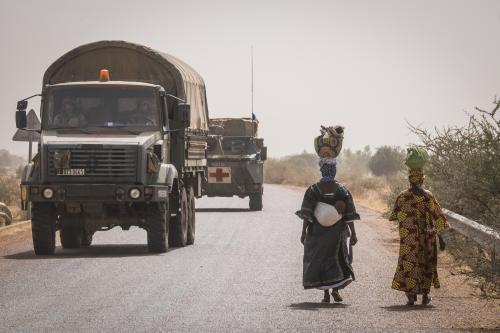Introduction
When Americans see televised images of bone-thin children with distended bellies, their humanitarian instincts take over. They don’t typically look at UNICEF footage and perceive a threat that could destroy our way of life. Yet global poverty is not solely a humanitarian concern. In real ways, over the long term, it can threaten U.S. national security. Poverty erodes weak states’ capacity to prevent the spread of disease and protect the world’s forests and watersheds—some of the global threats Maurice Greenberg noted in the Winter 2005 issue. It also creates conditions conducive to transnational criminal enterprises and terrorist activity, not only by making desperate individuals potentially more susceptible to recruitment, but also, and more significantly, by undermining the state’s ability to prevent and counter those violent threats. Poverty can also give rise to the tensions that erupt in civil conflict, which further taxes the state and allows transnational predators greater freedom of action.
Americans can no longer realistically hope that we can erect the proverbial glass dome over our homeland and live safely isolated from the killers—natural or man-made—that plague other parts of the world. Al-Qaeda established training camps in conflict-ridden Sudan and Afghanistan, purchased diamonds from Sierra Leone and Liberia, and now targets American soldiers in Iraq. The potential toll of a global bird-flu pandemic is particularly alarming. A mutated virus causing human-to-human contagion could kill hundreds of thousands, if not millions, of Americans.
Today, more than half the world’s population lives on less than $2 per day, and almost 1.1 billion people live in extreme poverty, defined as less than $1 per day. The costs of global poverty are multiple. Poverty prevents poor countries from devoting sufficient resources to detect and contain deadly disease. According to the World Health Organization (WHO), low- and middle-income countries suffer 90 percent of the world’s disease burden but account for only 11 percent of its health care spending. Poverty also dramatically increases the risk of civil conflict. A recent study by the UK’s Department for International Development showed that a country at $250 GDP per capita has on average a 15 percent risk of internal conflict over five years, while a country at $5,000 per capita has a risk of less than 1 percent. War zones provide ideal operational environs for international outlaws.
If in the old days the consequences of extreme poverty could conveniently be confined to the far corners of the planet, this is no longer the case. The end of U.S.-Soviet competition, the civil and regional conflicts that ensued, and the rapid pace of globalization have brought to the fore a new generation of dangers. These are the complex nexus of transnational security threats: infectious disease, environmental degradation, international crime and drug syndicates, proliferation of small arms and weapons of mass destruction, and terrorism. Often these threats emerge from impoverished, relatively remote regions of the world. They thrive especially in conflict or lawless zones, in countries where corruption is endemic, and in poor, weak states with limited control over their territory or resources. The map of vulnerable zones is global—including parts of the Caribbean, Latin America, the Middle East, Africa, the Caucasus, and Central, South and East Asia. Fifty-three countries have an average per capita GDP of less than $2 per day. Each is a potential weak spot in a world in which effective action by states everywhere is necessary to reduce and combat transnational threats.



Commentary
The Threat of Global Poverty
March 1, 2006